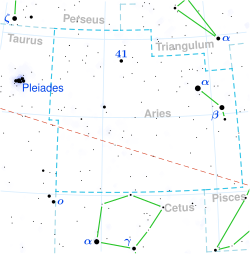Iota Arietis
Iota Arietis is a binary star system in the northern constellation of Aries. Its name is a Bayer designation that is Latinized from ι Arietis, and abbreviated Iota Ari or ι Ari. This star has an apparent visual magnitude of 5.117;[2] bright enough to be dimly seen with the naked eye. Parallax measurements yield an estimated distance of approximately 440 light-years (130 parsecs) from Earth.[11] The position of this system near the ecliptic means it is subject to lunar occultation.[12]
The variable radial velocity of this system was announced by W. W. Campbell in 1922. K. C. Gordon published orbital elements for this single-lined spectroscopic binary system in 1946, giving an orbital period of 4.29 years and an eccentricity (ovalness) of 0.36.[8]
For the visible component, in 1952 N. G. Roman found a stellar classification of K1p, where the 'p' indicates some type of peculiarity with the spectrum. Her comments indicated that the "Hydrogen lines and λ 4290 are strong enough to indicate a class II star, but the CN is barely strong enough for class III, and the Sr II is not much stronger than this would require.".[4] E. A. Harlan published a class of K peculiar in 1969, commenting, "Hδ strong, Fe I λ4045 is weak for type".[13] In 1990, K. Sato and S. Kuji gave a class of G8III, suggesting this is an aging G-type giant star and questioning its peculiar status.[5] Bayesian inference of the stellar properties indicates this star is on the horizontal branch.[3] The companion is a suspected white dwarf.[14]
References
[edit]- ^ a b c d Vallenari, A.; et al. (Gaia collaboration) (2023). "Gaia Data Release 3. Summary of the content and survey properties". Astronomy and Astrophysics. 674: A1. arXiv:2208.00211. Bibcode:2023A&A...674A...1G. doi:10.1051/0004-6361/202243940. S2CID 244398875. Gaia DR3 record for this source at VizieR.
- ^ a b c d Jennens, P. A.; Helfer, H. L. (September 1975), "A new photometric metal abundance and luminosity calibration for field G and K giants.", Monthly Notices of the Royal Astronomical Society, 172 (3): 667–679, Bibcode:1975MNRAS.172..667J, doi:10.1093/mnras/172.3.667.
- ^ a b c d e f Stock, Stephan; et al. (August 2018), "Precise radial velocities of giant stars. X. Bayesian stellar parameters and evolutionary stages for 372 giant stars from the Lick planet search", Astronomy & Astrophysics, 616: 15, arXiv:1805.04094, Bibcode:2018A&A...616A..33S, doi:10.1051/0004-6361/201833111, S2CID 119361866, A33.
- ^ a b Roman, Nancy G. (July 1952), "The Spectra of the Bright Stars of Types F5-K5", Astrophysical Journal, 116: 122, Bibcode:1952ApJ...116..122R, doi:10.1086/145598.
- ^ a b Sato, K.; Kuji, S. (1990), "MK classification and photometry of stars used for time and latitude observations at Mizusawa and Washington", Astronomy and Astrophysics Supplement Series, 85: 1069, Bibcode:1990A&AS...85.1069S.
- ^ Abdurro’uf; et al. (April 2022), "The Seventeenth Data Release of the Sloan Digital Sky Surveys: Complete Release of MaNGA, MaStar, and APOGEE-2 Data", The Astrophysical Journal Supplement Series, 259 (2): 35, arXiv:2112.02026, Bibcode:2022ApJS..259...35A, doi:10.3847/1538-4365/ac4414, ISSN 0067-0049.
- ^ Helfer, H. L.; Wallerstein, George (August 1968), "Abundances in K-Giant Stars. II. a Survey of Field Stars", Astrophysical Journal Supplement, 16: 1, Bibcode:1968ApJS...16....1H, doi:10.1086/190169.
- ^ a b Gordon, Katherine C. (1946), "The Spectroscopic Orbit of ι Arietis", The Astrophysical Journal, 103: 16–18, Bibcode:1946ApJ...103...16G, doi:10.1086/144784.
- ^ a b c Hekker, S.; Meléndez, J. (2007), "Precise radial velocities of giant stars. III. Spectroscopic stellar parameters", Astronomy and Astrophysics, 475 (3): 1003–1009, arXiv:0709.1145, Bibcode:2007A&A...475.1003H, doi:10.1051/0004-6361:20078233, S2CID 10436552.
- ^ "* iot Ari", SIMBAD, Centre de données astronomiques de Strasbourg, retrieved 2012-08-04.
- ^ van Leeuwen, F. (November 2007), "Validation of the new Hipparcos reduction", Astronomy and Astrophysics, 474 (2): 653–664, arXiv:0708.1752, Bibcode:2007A&A...474..653V, doi:10.1051/0004-6361:20078357, S2CID 18759600.
- ^ Herr, Richard B. (April 1969), "Identification List of Spectroscopic and Eclipsing Binaries Subject to Occultations by the Moon", Publications of the Astronomical Society of the Pacific, 81 (479): 105, Bibcode:1969PASP...81..105H, doi:10.1086/128748.
- ^ Harlan, E. A. (September 1969), "MK classifications for F- and G-type stars. I", Astronomical Journal, 74: 916, Bibcode:1969AJ.....74..916H, doi:10.1086/110881.
- ^ Eggleton, P. P.; Tokovinin, A. A. (September 2008), "A catalogue of multiplicity among bright stellar systems", Monthly Notices of the Royal Astronomical Society, 389 (2): 869–879, arXiv:0806.2878, Bibcode:2008MNRAS.389..869E, doi:10.1111/j.1365-2966.2008.13596.x, S2CID 14878976.

